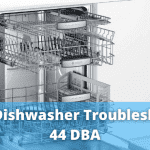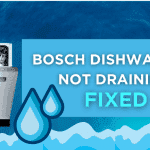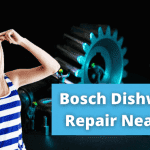Table of Contents
Finding out that your Kenmore Elite dishwasher is not draining can put you in hot water – it’s hardly the surprise you want after a long day! But don’t worry. It’s not all doom and gloom. Here’s a guide to three common issues and their solutions to get your Kenmore Elite dishwasher back in tip-top shape.
|
The Top Three Culprits
- The air gap is clogged. It’s a little-known fact that some dishwashers use air gaps to stop dirty water from contaminating your clean dishes. If it gets clogged, it can throw a wrench in your dishwasher’s ability to drain. If this sounds like your issue, it’s time to roll up your sleeves and give that air gap a good clean.
- The drain hose is clogged. Here’s another common issue. The drain hose can clog where it connects to the drain beneath the sink. This one’s an easy fix – loosen the drain hose clamp, clean out debris, and reconnect. You’ll be cooking with gas in no time.
- The drain hose is kinked. A kinked hose can stop the water from draining as smoothly as butter. Check the hose for any sharp bends and remove the kinks. It’s as simple as that.
Now, these solutions are usually enough to get things flowing again. But if you’re still in hot water and don’t feel like playing plumber, don’t hesitate to schedule an appointment with a professional.
Why Won’t my Kenmore Dishwasher Drain?
You’re not alone if your Kenmore dishwasher has hit a snag and won’t drain. Here are the most common issues:
| Issue | Cause | Solution |
|---|---|---|
| Clogged Sump Filters | Blocked with debris or grime | Clean or replace the filters |
| Defective Drain Pump | Pump isn’t working or lacks continuity | Replace the drain pump |
| Faulty Control Board | Defective board not supplying power | Replace the control board (professional help may be required) |
| Broken Drain Impeller | Impeller is broken | Replace the drain impeller |
| Failed Drain Solenoid Kit | Solenoid fails and the valve doesn’t open | Replace the solenoid kit |
| Blocked Drain Valve | Drain valve is clogged | Clean or replace the drain valve |
| Damaged Main Control Board | Defective main board not supplying power | Replace the main control board (professional help may be required) |
| Impaired Pump and Motor Assembly | Assembly doesn’t run during the drain cycle | Replace the pump and motor assembly |
| Clogged/Improperly Installed Garbage Disposer | Garbage disposer clogged or drain plug left in place | Remove the plug or clean out the disposer fitting and the drain hose end |
| Blocked Drain Hose | Drain hose is clogged | Clean out the drain hose |
| Stuck Check Valve | Check valve is stuck closed | Clean out and replace the check valve if necessary |
| Obstructed Check Ball | Check ball is stuck | Free up the check ball |
| Filthy Filter Assembly | Filters are clogged or dirty | Clean or replace the filters |
| Blocked Screen Filter | Screen filter is clogged | Clean or replace the screen filter |
| Clogged Strainer | Strainer is clogged with food particles | Clean or replace the strainer |
1. Clogged Sump Filters: These filters, both coarse and fine, can get blocked and reduce water flow, impacting the wash and drain function. You can remove and clean them with soap, warm water, and a brush. If they’re damaged or too dirty, replace them.
2. Defective Drain Pump: The drain pump uses an impeller to force water through the hose. If the pump isn’t working, it means no drainage. You can check the pump motor for continuity using a multimeter. If it lacks continuity or isn’t running despite receiving power, it’s time for a new drain pump.
3. Faulty Control Board: The control board supplies power to almost all electrical components in the dishwasher. A defective board might not power the drain pump, preventing water drainage. You may need a professional to diagnose this issue accurately and replace the control board if necessary.
4. Broken Drain Impeller: The drain impeller pushes water through the hose. If it’s broken, water isn’t going anywhere. You’ll need to replace the impeller.
5. Failed Drain Solenoid Kit: This kit opens the drain valve to let the water out. If the solenoid fails, the valve won’t open, and the dishwasher won’t drain. You’ll have to replace the solenoid kit.
6. Blocked Drain Valve: Debris can clog the drain valve over time. Clean out the valve to allow water to flow. If the valve isn’t blocked but still won’t actuate, replace it.
7. Damaged Main Control Board: Similar to the control board, the main control board provides power to every electrical part of the dishwasher. If it’s faulty, it may prevent the drain pump from operating. A professional might be needed for accurate diagnosis and replacement.
8. Impaired Pump and Motor Assembly: This assembly drives an impeller to force water through the drain hose. You should replace the pump and motor assembly if the motor doesn’t run during the drain cycle or hums without running.
9. Clogged or Improperly Installed Garbage Disposer: If you recently installed a garbage disposer, you might have left the drain plug in place. If your dishwasher connects to the disposer, remove the plug. If your disposer is old and clogged, clean out the disposer fitting and the drain hose end.
10. Blocked Drain Hose: To unclog a blocked drain hose, remove it from the dishwasher and the sink drain, then clean it out. The drain hose usually gets clogged near the garbage disposer or the dishwasher drain branch tailpiece.
11. Stuck Check Valve: This valve stops water from returning to the dishwasher after draining. If it’s stuck closed, it’ll prevent drainage. Clean it out and replace it if needed.
12. Obstructed Check Ball: The check ball is a small plastic ball in the check valve that prevents backflow. The water won’t drain through the check valve if it’s stuck. Free up the check ball to fix this.
13. Filthy Filter Assembly: The coarse and fine filters in the filter assembly can become clogged, disrupting the draining process. They need to be cleaned or replaced if they’re dirty or damaged.
14. Blocked Screen Filter: If the screen filter is clogged, it will interfere with the draining process. Cleaning or replacing the filter should solve this issue.
15. Clogged Strainer: The strainer in the sump catches food particles. If it’s clogged, the dishwasher may not drain properly. Clean it effectively or replace it if it’s damaged.
Frequently Asked Questions (FAQs)
My dishwasher still needs to drain. What should I do next?
If you’ve tried the solutions above and your dishwasher still won’t drain, it’s back to the grind for you. It might be time to schedule a repair appointment with a professional.
What causes a dishwasher not to drain?
The main culprits are usually a clogged air gap, a clogged or kinked drain hose, or a fault with the dishwasher, such as a faulty pump or control board.
How often should I clean my dishwasher’s drain hose?
It’s good practice to clean your drain hose at least once a year. However, if your dishwasher is not draining regularly, it might be worth checking it out more frequently.
How can I prevent my dishwasher from clogging?
In my experience, a good prevention strategy is to scrape food debris off your dishes before loading them into the dishwasher. Regular maintenance checks and cleaning will also go a long way in keeping your dishwasher running like a well-oiled machine.
Hopefully, this guide has given you peace of mind and a good starting point to troubleshoot your dishwasher issues. Remember, you’re not in the soup on your own – if in doubt, call the experts!




